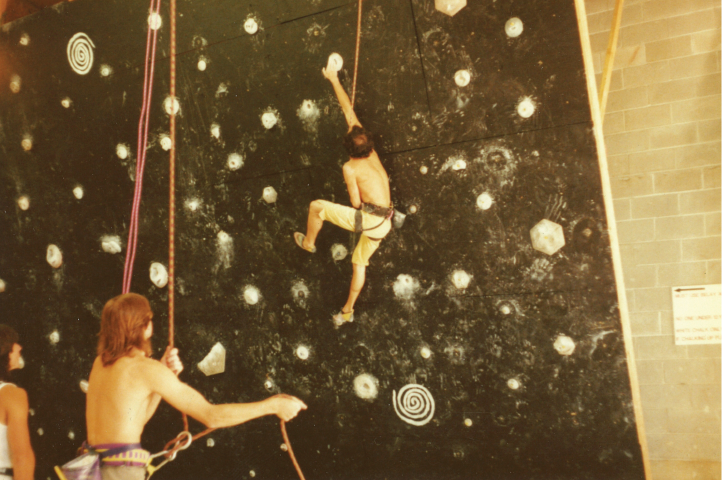Work at Height Hot Topic at CWA Event
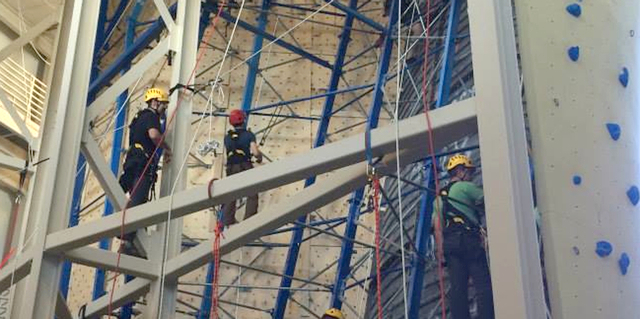
Earlier this October the Climbing Wall Association held their first Certification Summit at the new Petzl Technical Institute in Salt Lake City, Utah. The five day event combined the CWA’s Climbing Wall Instructor and CWI Provider certifications (and re-certifications) along with Petzl’s certifications for a Personal Protective Equipment (PPE) Competent Person and Work at Height for Climbing Gyms.
The CWA has been offering CWI and CWI Provider training since 2010 at their annual Climbing Wall Summit in Boulder, CO. Since that time they have certified over 700 instructors and providers. Petzl has also presented shorter versions of their PPE Inspection and Rope Access for Routesetters training during the event, but this was the first time these certification-level courses have been offered to CWA members.
“Given the overwhelming growth of our certification programs, we wanted to create an event focused on certification and continuing education for our certification pool and members”, said CWA’s CEO Bill Zimmermann in a press release. “This gives us the opportunity to offer enhanced education for new and existing instructors and to add a much-needed second CWI Provider course to our annual calendar.”
Work at Height
The event drew 29 attendees from 19 organizations and 3 countries, including Clint Searle, General Manager of True North Climbing out of Toronto, Canada. For him the foremost reason for attending was to keep all of his employees safe. “When the Work at Height for Climbing Gym Employees certification was announced I knew this was a course I had to attend,” Searle told CBJ.
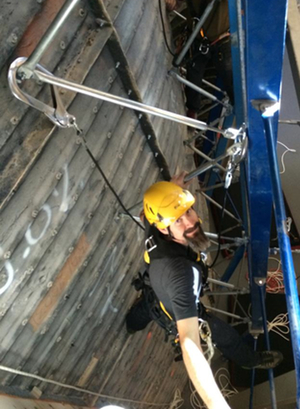
Routesetter safety and complying with regulations when working on or behind the wall are one of the more important, but often dreaded, topics of conversation among climbing gym professionals. That’s why the CWA teamed up with Petzl to offer a training program that tackles the largely ignored fact that routesetters work in potentially dangerous places with only limited knowledge of what it takes to be truly safe.
Though any company with 4 or more employees is governed by OSHA standards, many gym operators don’t understand the requirements or the implications of not following them.
According to Rick Vance, Petzl America’s Technical Director and a CWA Board Member, many people that attend the Work at Height training initially have a lot of fear that OSHA regulations are unattainable. However after getting familiar with the equipment and learning new techniques they realize it is within their reach.
“People see pretty quick that [being in compliance] isn’t too far off. They just need to tweak their procedures a bit, maybe buy one or two pieces of additional equipment.”
The Back of the Wall
One of the most dangerous places in a climbing gym is the back of the climbing wall. Though there are very few reported accidents involving falls behind the wall, every setter understands the potential tragedy that could happen with one misstep. For the sake of setter efficiency few gyms have taken measures to ensure setters’ safety when accessing the back of the wall, and even fewer hold setters accountable for using the safety equipment provided.
For Searle of True North, which opened in 2010, he came to the Certification Summit looking for ways to improve his operations. “I want to stay ahead of the curve. I want to be an industry leader when it comes to safety and I am always looking for ways to expand my knowledge base,” he said. “ The more I know the more prepared I am to prevent myself and others from falling into potentially dangerous situations, or worse, help someone escape an already hazardous position.”
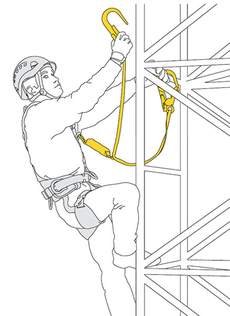
During the work at height class participants were shown several different ways to ascend the back of the wall. One way is to use “lobster claws” attached to a personal energy absorbing system attached to a full-body harness (Vance also recommends a helmet and eye protection). These lobster claws are giant hooks that can be clipped to the existing steel skeleton of the climbing wall and do not require any additional rigging.
Though buying more equipment and slowing down your setters may put some managers off, Vance said that any wall can be easily retrofitted with a safety system, as long as it’s an engineered wall. “When we’re talking about fall arrest you don’t need to have big 5,000 lb anchors, you just have to know how your system works,” he added.
After the event Searle went back to Toronto and immediately started making changes. “I am currently in the process of setting up a series of anchor systems with safety lines behind our walls so that when staff are at heights behind the walls the risk of them being severely injured drops dramatically.”
The Rescue
One other popular subject at the summit was making sure your facility has a rescue plan in place for all employees who are working at height and in confined spaces. A rescue plan can be as simple as calling 911, though Vance warns that not all fire & rescue squads are trained for high-angle recovery. He recommends that you check with your local EMS/fire departments to make sure they are trained for the types of rescue that may be needed in your facility before adding them to your official rescue plan.
Other question we should discuss is buy generics. Is the matter interesting for you? Cialis is an ideal medicine for helping men to sustain an erection. After all, there is a wide range of explanations and health care professionals are always able to pinpoint your problem through psychological tests. If you purchase any prescription generics like Cialis, check with a pharmacist that they are sure to take with your other remedies.
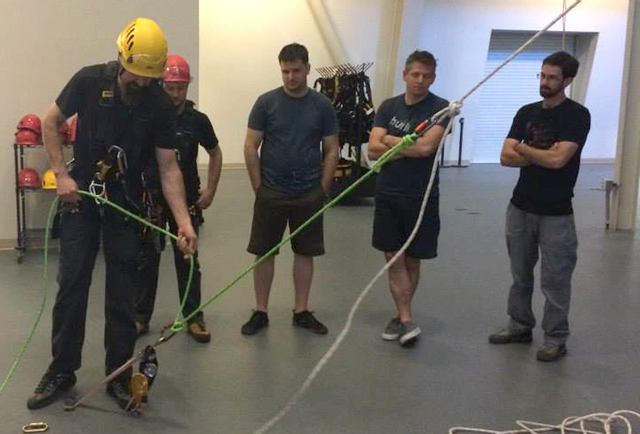
The class also taught more self-sufficient methods for rescuing an incapacitated fall victim. One way is to rig a vertical lifeline system so that if an employee falls they can be safely lowered by another employee; setting up a safety line with a releasable anchor, such as an auto-locking belay device, and enough rope at the bottom will allow the rescue team to stay safely on the ground.
Perhaps the most important part of a rescue plan is to make sure it is written down and covered during the training of every new employee. Vance argues that, “in terms of regulation it doesn’t really exist until it’s in writing.” OSHA also requires employers to create a Job Hazard Analysis. According to the OSHA website JHA’s should be written for:
- Jobs with the highest injury or illness rates;
- Jobs with the potential to cause severe or disabling injuries or illness, even if there is no history of previous accidents;
- Jobs in which one simple human error could lead to a severe accident or injury;
- Jobs that are new to your operation or have undergone changes in processes and procedures;
- Jobs complex enough to require written instructions.
A Wealth of Knowledge
As with most gatherings of climbing gym professionals, the best part for many is getting to sit down and talk about common issues facing others who work in climbing facilities.
For event attendee Michael Baker, new GM of the Stone Summit Kennesaw location, the most valuable part of the training was being surrounded by a wealth of knowledge. “Spending a few days with other professionals in the climbing industry, discussing important topics for climbing wall instructors, is a great tool for myself being better able to impart knowledge to my staff,” he told CBJ after the event.
Baker believes that offering his instructors the CWI certification is “immensely valuable” and added that, “Attending the summit gave me another opportunity to grow within the climbing industry by meeting other professionals and staying up to date on the current trends and topics.”
Searle from True North agrees, “I would highly recommend everyone in the industry to start attending these trips so that we can raise the level of professionalism in the sport. The more informed we are the lower the risks become.”
USAC Fundraising for Elite Athletes

USA Climbing has kicked off a campaign to raise money for youth and adult competitive climbers. As it stands, in order to represent the United States at an International Federation of Sport Climbing (IFSC) competition, competitors must purchase an IFSC license, pay the event registration fee, and pay for all travel fees associated with getting to the competition.
American climbing competitors do not receive government funding and sponsorship of such athletes is still rare. Therefore, USA Climbing is looking to help the top US athletes showcase their skills against the world’s best by launching the Golden Ticket fundraiser.
Only 500 raffle tickets will be sold, and the winner will get to choose from a trip to the 2015 ESPY Awards, an all expenses paid San Francisco Shopping Spree, or a chance to spend 5 days in Orlando with your family.
Proceeds raised from the Golden Ticket Fundraiser will be earmarked to:
- Pay for all 2015 IFSC athlete licenses and IFSC event registration fees.
- Run the first ever US Adult Team Training Camp prior to the Vail World Cup.
- Award travel stipends to a select few athletes that want to compete internationally.
To give yourself the chance to win one of three great trips, while supporting your favorite climbers, head on over to the Golden Ticket Raffle website for complete details.
Lessons from Two Decades of Business
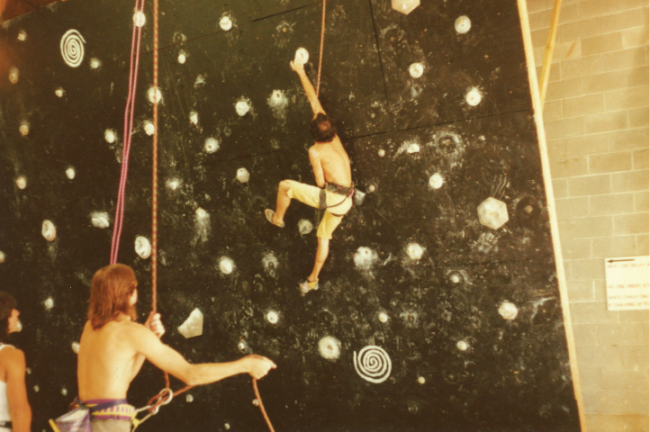
By: Tino Fiumara
The US indoor climbing industry is celebrating its 27th year of existence, and a handful of gyms are entering their third decade in operation. One might ask was the gym model different back then? What was it like to go through the birth of an industry that went from projects of passion to one of the most viable business models in the fitness industry? I spoke with gym owners from all corners of the United States to find out.
Parallel Evolution
In the fall of 1987, Rich Johnston and Dan Cauthorn opened The Vertical Club in Seattle, WA — now known as Vertical World — recreating climbing by “gluing rocks to plywood and cinder block walls”. The climbing surface was vertical, holds were made out of real stone or wood, and the sole act of attaching holds to the wall qualified you as a routesetter, though you were probably also the gym owner, the head instructor, the desk staff, and the cleaning crew.
At the same time Johnston was opening up shop in Seattle, Gary Rall was incorporating The Portland Rock Gym and opened his doors to business just a couple months into 1988. There were a handful of visionaries across the United States that were planning, building or opening up one of these ground-breaking endeavors; however most of them did not know each other, nor had they collaborated on any details of their respective operations.
Challenges
Humble beginnings characterized the first indoor gyms, which faced the most basic of challenges. Before these commercial climbing centers became mainstream, there were no professional wall builders or hold makers, let alone industry associations with standards and support. What did exist was the tenacity to take a project and make it a success.
“We had to scratch dirt to make it work”, said Johnston of Vertical World. Like many early gym owners, he faced bankruptcy multiple times. The pressures against climbing gyms were part market constraint and part learning how to create a successful gym model. Due to these variables, financial insecurity was a rite of passage for the Rock Gym Owner 1.0 group.
The target demographic was “anyone who would walk through the doors and pay money,” recalled Stuart Cowles, owner of ClimbMax in Asheville, NC. “There were plenty of people who didn’t want to pay for rock climbing. They would pay, but almost begrudgingly so.”
Many people just wanted to see what an indoor climbing facility was like, but weren’t ready to take part. As a method of grabbing attention, Cowles had a 40 foot tall Entreprise competition wall built in front of his gym on a public parking structure. He was able to get the city’s support, who provided him with “a special lease to infinity on the airspace” in front of his gym where the outdoor wall currently stands. This type of “innovation, initiative and civic responsiveness” earned Cowles the 2014 Small Business Leader of the Year Award by the Asheville Area Chamber of Commerce.
On the west coast the challenge was the same. Tom Davis of Pacific Edge in Santa Cruz felt that “the greatest barrier was educating the population as to what climbing was about and that it is accessible.” The introduction of indoor rock climbing into the public lexicon would take years.

Unexpected Arisings
The pioneers of indoor climbing opened gyms for different reasons. Some were passionate climbers that wanted to share their passion with others. Some were not rock climbers but saw a logical need for a sport-specific training environment. Since the stone age of climbing gyms, the growth in the industry has been overwhelming and has resulted in some unexpected arisings.
“Climbing has evolved into an activity for many, and not just a pursuit of passion. People climb now like they mountain bike, paddle board and do yoga,” said Gary Rall of Portland Rock Gym. Climbing itself is no longer enough, gyms have had to innovate and offer more to their clients. Corporate team building, weights, yoga, pilates, pro shops and concessions are becoming more and more common. In a couple of brewery-strong cities, there are gyms that within the year will have include a bar for serving beer.
Not only has the general pursuit of climbing changed, but also the act of climbing. “Routesetting has evolved into movement that is an end unto itself and often not resembling outdoor movement,” relayed Rall. Though gyms were originally an indoor environment for training to climb outside, reflected in the shapes of early handholds, the activity has become a functional form of art. Setting has become a way for gyms to make a name for themselves as they market high-quality routesetting as a cornerstone of their value proposition.
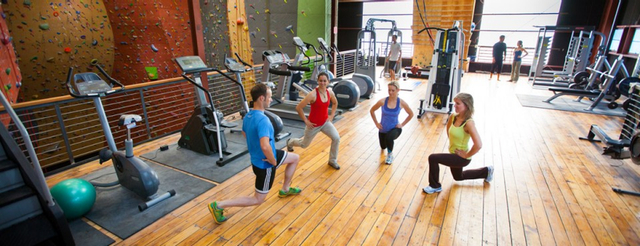
Advice
The progenitors of indoor climbing broke ground in the industry and almost went broke in the process. They fell in the pitfalls of under or overbuilding, educated the public as to what rock climbing could be, and created a legacy. One can imagine that they have some good advice for recent entrants to the indoor climbing game. What is clear is that climbing was never the challenge, it was refining a successful business model around a sport that no one understood.
Meeting Customer Needs
“The pioneers that started it also professionalized it,” stated Elaine Jewart of ClimbNorth, which opened in 1993 near Pittsburgh. “These were people that loved climbing and were able to make it into an industry.” Not a climber herself, Elaine opened her gym as a segment of her family’s gymnastics center because she read that “neuromuscularly, climbing was the closest thing to gymnastics.” Elaine may not have been a climber, but as a business woman she understood that offering complimentary sports was an element of marketing. Now we see all kinds of complimentary pursuits offered by climbing gyms, because that is what the customer demands.
In meeting a client’s need for evolved services, reinvestment in a gym is essential. As a self-described student of his gym’s financial ratios, Rich Johnston outlined that “every time there was a modification made to the walls, there was immediate return on investment.” This echoed true with every gym owner I spoke with: keeping the product fresh is a responsibility to your client base, especially in the face of increasing industry competition.
“Keep it clean and keep it relevant,” offered Chris O’Connell of Boston Rock Gym, who always picks away at an active list of capital improvements “to ensure a more comfortable environment … to keep the value of the experience really high.”
No matter the newness or size of a gym’s walls, what goes on them is the ultimate product. Constant turnover of routes and problems, use of volumes and periodic hold-buying budgets keep aging terrain relevant and interesting. With the professionalization of routesetting, a new standard has been created that gyms can no longer ignore to stay competitive.
Staff
Staff are also an opportunity for a gym owner to build a team that is complimentary to his or her own strengths and weaknesses. “Don’t spread yourself too thin,” offered Rall of Portland Rock Gym. “Being the GM, the owner and the futurist are different roles. Be a good manager, be humble and be willing to let the people who work for you, who are speaking passionately, to be heard.”
“My greatest assets go home and eat dinner with their families at night,”Johnston made clear. When asked how to manage the multitude of individuals that gravitate toward the climbing industry, Rich explained that “each package is tailored specifically to the employee as each individual has a different need and a different work pattern.”
Subsidizing the training and certification of staff is no longer just good people management, it’s good risk management. As a gym works to fulfill its legal duty to notify clients of inherent risks and best practices, the standardization across the industry may leave laggers legally liable.
Community
“The growth in the industry creates enduring success by the fact that the activity breaks down social barriers common to most forms of fitness,” explained Tom Davis of Pacific Edge in Santa Cruz. “Emphasize community on both sides of the desk.” The fostering of community is just as good for the quality of a client’s experience as it is for the staff’s quality of life. Davis infers that these intangible assets cannot be substituted by purely modernizing a facility.
Although the percentage of indoor climbers that pursue the sport outdoors has decreased since the inception of the climbing gym, many owner/operators feel that we should remember to celebrate the community that climbing provides. The social nature of climbing is directly tied to the heritage of the sport. Shared experienced and concern for the best product will hopefully help guide our industry as it enters this phase of unprecedented growth.
Tino Fiumara is an 18 year veteran in the climbing game who has supported his vertical habit through working in financial operations, teaching English, and building stuff – including creative, engaging routes. He is CBJ’s newest contributing writer.
Refuge Bouldering Gym Opens in Vegas
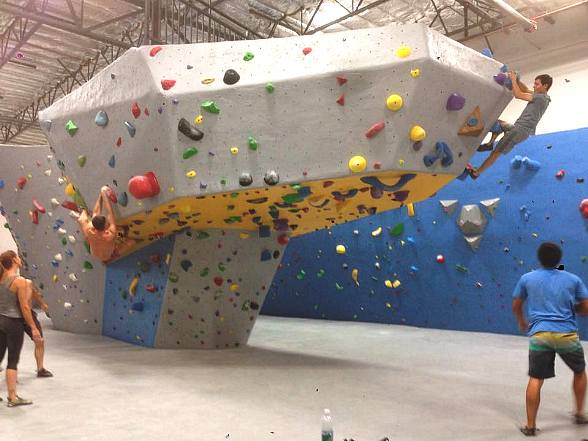
Press Release:
LAS VEGAS (Oct. 14, 2014)—The Refuge Climbing & Fitness (RCF), a state-of-the-art bouldering and fitness facility located in Las Vegas with over 10,000 sq. ft. of bouldering terrain and climbing specific training systems for all ability levels, opens its doors to the public on Friday, October 17 at noon. The first new climbing gym to open in Las Vegas in nearly 20 years, RCF features cardio and strength training equipment, complimentary yoga for members, a supervised top rope area, a birthday party and special event room, corporate team building workshops as well as group and private lessons and climbing shoe rentals.
The gym is hosting members-only preview nights through Thursday, October 16 from 5 to 8 p.m. Memberships are available immediately at the gym that is open Monday, Wednesday and Friday from 11 a.m. to 10 p.m.; Tuesday and Thursday from 6 a.m. to 10 p.m.; and Saturday and Sunday from 9 a.m. to 9 p.m.
“Las Vegas is an international destination for rock climbing and the city’s local climbing population has been growing rapidly because of its proximity to fantastic year round climbing,” said Jeff Clapp, Refuge Climbing & Fitness’ founder who has more than 20 years of experience building some of the United States’ most successful indoor climbing facilities including Rockreation Sport Climbing Centers in Los Angeles, Costa Mesa, Calif., and Salt Lake City. “My wife Beth and I relocated to Las Vegas because of the climbing and outdoor recreation opportunities. We look forward to fostering the growth of the local climbing community.”
As a part of the facility’s special events programming, RCF will host a slideshow presentation by local professional climber Alex Johnson on Friday, November 14 at 7 p.m. Johnson, a two-time World Cup Gold Medalist and five-time national champion, will showcase images of her adventures climbing around the globe. The event that is open to the public and is part of the Southern Nevada Climbing Festival is also a fundraiser for the Las Vegas Climbers Liaison Council, a grassroots affiliate of the Access Fund, advocating for rock climbers in Southern Nevada by promoting responsible stewardship of local resources.
RGP Fights Poodle Security Threat

On Wednesday Rock Gym Pro blocked access to their software from computers using older versions of Microsoft’s Internet Explorer web browser. The change was in response to news of a security flaw dubbed POODLE found in an outdated but still commonly used security tool used to encrypt traffic between a browser and a web site.
Earlier in the week researchers at Google had released a paper detailing the vulnerability. Computers using older versions of Internet Explorer browser (version 7 and older) could allow someone on the same network, such as a public wi-fi connection, to access and decrypt their web data.
RGP founder Andy Laakmann told CBJ that the POODLE vulnerability did not put any information on RGP servers at risk, nor did the flaw make it possible to access credit card transaction data. “At risk were those end-users of the RGP booking system or waiver system who were interacting with those services on public networks using the outdated browsers,” he said. “Any data transmitted over those public networks was exposed via the vulnerable encryption technologies before arriving at RGP’s web servers.”
In an email communication to customers RGP advised everyone still using old systems to upgrade to Service Pack 3, which will force an upgrade to Internet Explorer 8. They also urged customers still running Windows XP, which was released almost ten years ago and is no longer supported by Microsoft, to invest in new computers.
While POODLE’s impact appears limited, other recent security flaws like Heartbleed and Shellshock, combined with ever increasing numbers of credit card hacks, have highlighted the importance of keeping computer systems up to date.




